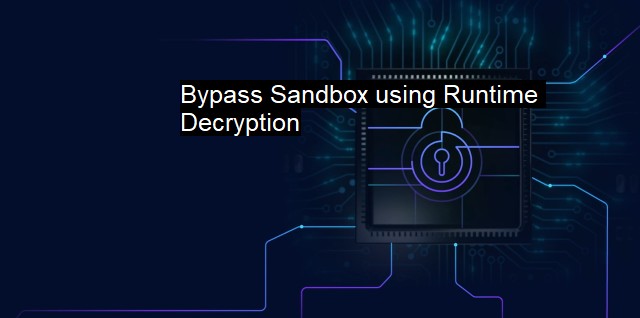What is Bypass Sandbox using Runtime Decryption?
Bypassing Sandboxes Using Runtime Decryption: Threats to Antivirus Systems and Cybersecurity
The notion of "Bypass Sandbox using Runtime Decryption" has emerged as a notable topic of discussion owing to its relevance within the environment of antivirus programs. To thoroughly understand this concept, we must first dissect it into its primary parts: 'sandbox', 'runtime decryption', and how the two elements combine to enable a potential evasion of safeguarding systems.A 'sandbox' stands as a safeguarding response within cybersecurity systems. A confined environment that operates independently of its host system, the sandbox serves as an isolated and controlled atmosphere employed for running unverified and suspicious code. The primary objective of a sandbox is simple: to isolate potential threats so that they cannot impact or interact with the host system. Evidently, this tool forms an integral part of the first line of defence within antivirus programs, shielding software systems from potential harm.
On the other hand, runtime decryption involves decrypting data only when it is needed, rather than decrypting all encrypted data upon starting a program. In encryption, data is transformed into an unreadable format to prevent unauthorized access. at times, a program needs access to this secured data during its operation, and this is where runtime decryption comes into play. By decrypting data only when required, this technique can greatly minimize potential exposure to cyber threats.
In the context of "Bypass Sandbox using Runtime Decryption," the idea includes intercepting defensive mechanisms using the latter concept. A malicious actor uses runtime decryption as a cipher that hides rogue programs within an innocent facade, making the malicious code undetectable to anti-malware software scans. Typically, antivirus programs assess files within a sandbox to ascertain their safety. because runtime decryption only reveals the data when activated during execution, it fails to concede the authentic nature of the item analyzed.
The amalgamation of these two processes signifies a potential weakness within security networks. Convoluted decryption sequences can conceal potentially harmful functions of malicious software, resulting in an evasion

Bypass Sandbox using Runtime Decryption FAQs
What is runtime decryption in relation to sandboxing?
Runtime decryption refers to the technique of bypassing sandboxing by encrypting malicious code at runtime, effectively masking its true nature from antivirus software and other security measures. This makes it easier for attackers to evade detection and compromise a system.How does runtime decryption work?
Runtime decryption works by encrypting malicious code in a way that it cannot be detected by antivirus software or other security measures. The encrypted code is then decrypted and executed at runtime, making it difficult for security software to detect the malicious intent of the code. This technique allows attackers to bypass sandboxing and other security measures designed to protect a system from malware.What are the risks of bypassing sandboxing using runtime decryption?
Bypassing sandboxing using runtime decryption can pose significant risks to a system and its users. Since the malware is hidden from detection by antivirus software and other security measures, it can easily compromise a system and steal sensitive data or perform other malicious activities. This can result in major data breaches, financial losses, and other serious security threats.How can organizations defend against runtime decryption attacks?
Organizations can defend against runtime decryption attacks by implementing a layered security approach that includes advanced malware detection and prevention tools, intrusion prevention systems, and application control measures. Additionally, regular security audits, employee training, and other best practices can help reduce the risk of runtime decryption attacks and other cyber threats.| | A | | | B | | | C | | | D | | | E | | | F | | | G | | | H | | | I | | | J | | | K | | | L | | | M | |
| | N | | | O | | | P | | | Q | | | R | | | S | | | T | | | U | | | V | | | W | | | X | | | Y | | | Z | |
| | 1 | | | 2 | | | 3 | | | 4 | | | 7 | | | 8 | | |||||||